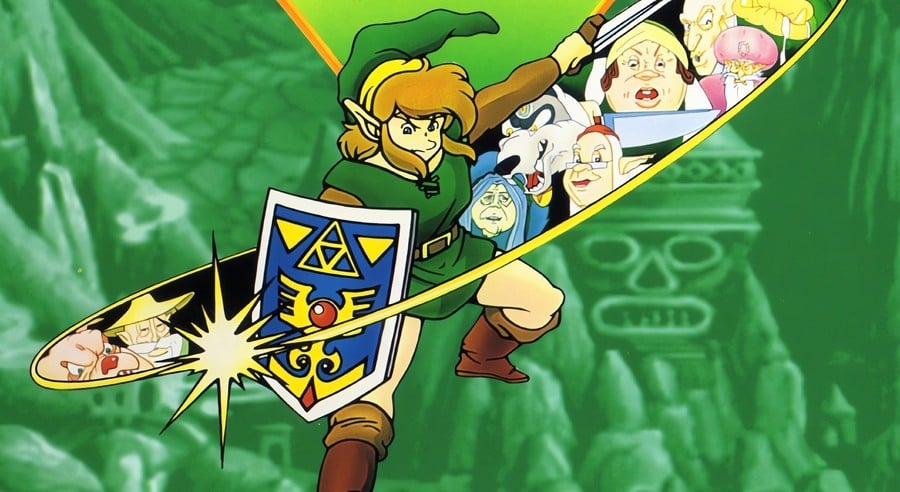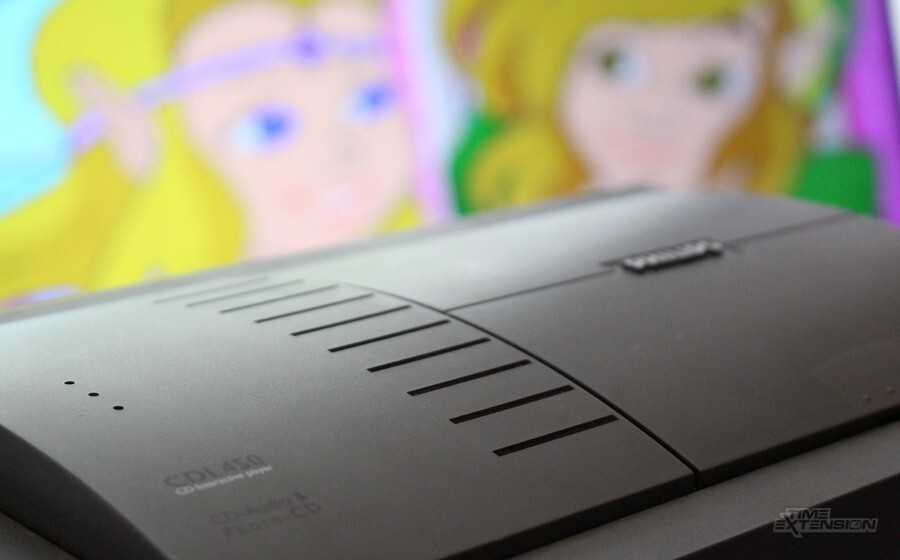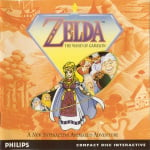
The Legend of Zelda series is home to some of the most critically-acclaimed video games ever made, and the franchise is without a doubt one of the most important in Nintendo's illustrious catalogue. However, there a few titles within the lineage which stick out like a sore thumb — the trio of Zelda games produced by Philips under license for its CD-i multimedia platform.
These games — Link: The Faces of Evil, Zelda: The Wand of Gamelon and Zelda's Adventure — all came about as a result of Nintendo ditching Sony as a hardware partner for the proposed SNES-based PlayStation console and promptly hopping into bed with rival Philips, only to back out of that deal as well. As a way of softening the exit, Nintendo gave Philips the rights to produce games based on Nintendo characters for its CD-i system.
The Faces of Evil and The Wand of Gamelon are perhaps the most famous of this trio, and were produced simultaneously by Animation Magic, a company established by Dale DeSharone (the third title, Zelda's Adventure, was created by Viridis). Adopting a side-scrolling perspective similar to that seen in Zelda II: Adventure of Link, these games have been crucified in recent years thanks to the perceived lack of quality when compared to traditional Zelda games, and because of the often comical 2D animated cut-scenes which bookend the action. However, the story behind them gives much-needed context to their development.

DeSharone was a teacher before he moved into game development, and would be involved with both Atari and Commodore during the early years of the '80s. Perhaps his most critically acclaimed work was an adaptation of Zilpha Keatley Snyder's fantasy novel Below the Root for MS-DOS PC, C64 and Apple II. He would later work with the team which came up with the Red Book Audio standard for CD-ROM, and was a key figure in helping the games industry take its first lumbering steps into the compact disc revolution. However, it is the first two CD-i Zelda outings which take perhaps the most notable position on his considerable CV.
Back in 2005, video game journalist and Time Extension contributor John Szczepaniak — the man behind The Untold History of Japanese Game Developers — was lucky enough to speak to DeSharone. During a series of conversations which would span almost an entire year, DeSharone shed some light on the troubled genesis of the CD-i Zelda titles, and explained some of the issues he and his team had to deal with in order to even get them to market.
Philips was planning to release the machine in 1988. That one year turned into four, due to constant delays with the hardware emulation systems and the operating system
Prior to working on the games, DeSharone joined Boston-based Spinnaker Software, a company which had inked a deal with Dutch electronics giant Philips to produce games for its then-unreleased CD-i system. "I was brought on to help understand the capabilities of the platform and act as design lead," he told Szczepaniak back in 2005. "My immediate supervisor, Steve Yellick, was a guy out of MIT who knew a lot about laser technology and image compression and had been a part of the original Red Book specification team. He didn't know much about building games, however." Yellick would tragically take his own life about a year into the project, and DeSharone became the manager of the development group. "We built Laser Lords, Alice In Wonderland, Sargon Chess, Paint School I, Paint School II, Story Machine I and Story Machine II. I designed, programmed, wrote editing tools and engines, and hired and managed artists, programmers and audio engineers."
Despite his pivotal role in the operation, DeSharone didn't see Spinnaker as a company he would be with forever — but events transpired which kept him there for longer than anticipated. "Philips was planning to release the machine in 1988," he said. "That one year turned into four, due to constant delays with the hardware emulation systems and the operating system. I think the launch was closer to 1991. Unfortunately for Philips, as each year passed CD technology made more inroads into being a standard part of PC and Mac computers. And while the PC was getting more memory and faster processors, Philips chose to stay with the original 1987 specification using the 68000 chip — the original 68000 found in the first Macintosh computers. It was dreadfully slow and severely limited what was possible with the system. There was no hardware sprite technology so all movement of characters required the pushing of pixel data by that 68000 chip. There was some hardware scrolling capability but the video memory was very small — if you look at the scrolling in Laser Lords, Alice In Wonderland, Link or Zelda you’ll see that you can only scroll about two or two-and-a-half screens horizontally. This was dictated by the video memory available."
The lack of gaming clout was made worse by other elements of the hardware, most notably the famously terrible CD-i remote control. "The infrared controller was analogue instead of digital, and the infrared made it extremely slow and unresponsive," said DeSharone. Ironically for a system built around the compact disc, the CD-i's audio capabilities also caused headaches.
"It had no MIDI music capability or sound effect generation processor," DeSharone explained. "One might think — as Philips did — that those things wouldn't be needed when you can play full CD audio or multiple levels of Adaptive Pulse Code Modulation compressed audio. But, those forms of audio data had to either stream off the CD or be stored in memory, and even the lowest level of ADPCM took up a lot more space than MIDI data or sound chip code. Of course, the CD-ROM was also a problem. The drive was single-speed with really abysmal seek times. If you were streaming music off the CD, you couldn't go out and seek graphic data at the same time, unless you interleaved the graphics with the audio — which was possible but limited interactivity. There was also the issue of the small, Non-Volatile RAM Card as the only mass storage. So, you had a system which may have been better suited to large RPG or Strategy Games, but couldn't easily save complex game states."
Somehow, Philips got a deal with Nintendo to license characters — as I understood the arrangement, it wasn't a license of five games, but five characters
To the men in charge at Philips and American Interactive Media — Philips’ CD-i software publishing arm — this mattered little, as the machine was supposed to be an all-in-one multimedia powerhouse rather than a rival to the likes of the NES and Sega Mega Drive / Genesis. "It was just obviously not a game system, and Philips was actually very clear in telling us that they didn't believe the market for this device was games," DeSharone said. "There was a subtle hostility toward games that I noticed from the upper echelon of execs. This all changed after the launch of the CD-i platform because the only titles that actually sold were the game titles."
Once Spinnaker’s initial commitment of seven games was fulfilled and it became clear that the studio's owners had little interest in continuing CD-i development, DeSharone left and set up his own firm. "Most of the CD-i team from Spinnaker left to join this new group," he explained to Szczepaniak. "This is where the Link and Zelda story begins. Somehow, Philips got a deal with Nintendo to license characters — as I understood the arrangement, it wasn't a license of five games, but five characters. A number of developers pitched American Interactive Media with ideas. I think American Interactive Media chose to go with the biggest names that Nintendo had at the time. We pitched separate ideas for a game starring Link and a separate one with Zelda. The development budgets were not high; as I recall, they were perhaps around $600,000 each. We made a pitch that we could maximize the quality of the games by combining the funding to develop only one game engine that would be used by both games."

The desire to keep costs low was totally understandable, given the small size of Animation Magic and the inherent costs involved. "This was in 1991-1992, and even at this time, a US technical employee cost about $100,000 per year to support — salary, taxes, office space, equipment, insurance, administration costs," said DeSharone. "This was also a time when a 1GB hard drive cost $3000. We had a team of three programmers — other than myself — one audio engineer/composer, four artists and a producer. We had a single freelance writer who wrote the scripts and helped design both games."
Igor wanted to return to St. Petersburg for the first time in twelve years and build a company there that would provide some type of service to U.S. companies
Given the potential for "next-generation" visuals on the CD-i , American Interactive Media had high hopes for the titles. "I was trying to figure out how we were going to do that on the budgets," said DeSharone. The answer would come from Russia. "A mutual friend put me in touch with Igor Razboff. Igor was also interested in starting a new technical company at this time. He had a PH.D. in Higher Mathematics and Computer Science from the university in St. Petersburg, Russia [and] had been in the U.S. for twelve years [working] at Bell Labs and Computer Vision. Perestroika was beginning and the Berlin Wall was coming down. Igor wanted to return to St. Petersburg for the first time in twelve years and build a company there that would provide some type of service to U.S. companies."
That service would ultimately be creating animated content for the burgeoning number of CD-ROM games that were starting to emerge on the market. The new storage medium had opened the floodgates as far as content was concerned, and studios were beginning to add in animated introduction sequences and Full Motion Video clips to pad out the massive amount of space they now had access to. DeSharone and Razboff therefore decided that it would make sense to use cheaper Russian animators to produce this kind of material for western games under the Animation Magic banner.
"I had seen numerous animated films coming out of Eastern Europe and the former Soviet Union, so I thought we could probably do animation over there," DeSharone recounted. "So [Razboff] went over [and] found about six people who had some experience with 2D animation — and of course, they didn’t have the expertise that US animators have. We brought them over here to the US for six months and put them up in an apartment. [We] gave them computers and scanners. Most of them at that time worked on animation paper, then scanned it into the computer and cleaned up the lines and colours, and then we transferred it to CD-i. The animators had varying levels of skill, in terms of animation."
Nintendo’s only input was we ran the design document and character sketches past them for their approval
Given Nintendo's current stranglehold on its intellectual property, it seems almost unthinkable that Russian artists-in-training would be allowed to tinker with such prized characters as Link and Zelda, but back in the early '90s, the Japanese firm was clearly a little less uptight about what external studios did with their franchises. "Nintendo’s only input was we ran the design document and character sketches past them for their approval," said DeSharone. "They were mostly interested in the look of the Link and Zelda characters. I think the characters were in somewhat of a formation stage back then, because really [they] didn't appear as characters in the Nintendo game — they were on the box covers. We only had the two Nintendo games that had come previously [for reference] and then art from Nintendo in terms of the design — box and booklet artwork. Otherwise, there wasn't anything that came from Nintendo."
The animated cut-scenes in both of the CD-i Zelda titles have become the stuff of legend. While they were moderately impressive when compared to the kind of animation being seen on other CD platforms at the time, they felt totally and utterly at odds with the Zelda universe and the characters which Nintendo had nurtured through the NES adventures. "We were working on the games simultaneously, so we were working on the script, on the design and the artwork, and the animation to both games at the same time," DeSharone explained. "We auditioned local union actors, AFTRA [American Federation of Television and Radio Artists] actors, and chose the voices for the game. There’s about ten minutes of cinema in each game, so there was a fair amount of audio to edit.”
DeSharone and his team had a lot of creative freedom, liberated from interference not only from Nintendo but also from Philips itself. However, Animation Magic did make one significant move to appease its client. "We didn't go with the top-down [view], and I think Philips would never have approved that because they would have thought that looked old and wasn't making use of the CD-i capabilities. They would have looked at it just visually, as opposed to gameplay. And that was what they were most concerned with. Does the CD-i game look visually different from other game or computer systems, and are we making less use of the graphics? The possibility that the top-down might have been more fun for gameplay, [that] wouldn't have affected them. So we definitely pushed for the side view."
I can understand that people were disappointed. Given the amount of time we had — and what we were creating at the time in terms of company infrastructure — I thought we did a good job
The two titles were produced in just over a year — an incredibly tight development cycle even by the standards of the early '90s, and almost herculean when you consider that the small team was working with emerging CD-ROM technology. While the games were largely ignored by the mainstream gaming press at the time of launch, they received a rather more positive response from CD-i owners starved of big-name releases on the ailing system. In the years that followed, this lukewarm response turned to aggressive criticism and widespread condemnation, and these days the games are seen as sacrilegious abominations by some dedicated Zelda aficionados — whereas, in reality, their biggest crime is simply not living up to the high standards of the series.
Even back in the middle of the last decade, before the wonders of YouTube allowed people to upload the animated cut-scenes from the CD-i Zeldas so the entire world could participate in mocking them, DeSharone was well aware of the dismal reception afforded to the games he and his team worked so hard to create on a shoestring budget and against a tight deadline.
"I can understand that people were disappointed," he told Szczepaniak. "I guess they made comments about animation, but also in terms of gameplay and design. Given the amount of time we had — and what we were creating at the time in terms of company infrastructure — I thought we did a good job. You know, we weren’t Nintendo — and Nintendo makes fantastic games, which are exceptionally well-tuned in terms of gameplay. They have amazing game designers. I would imagine that anything was going to fall short of that, in terms of the amount of time and energy that Nintendo puts into gameplay. At the same time, Philips was expecting — and I think we were all expecting — [better] graphics and [higher] production values in terms of music, visuals [and] animation. So there was a lot of push there. You put effort into that, and it doesn’t go elsewhere. I felt that given the circumstances — developing two [games] at once on a platform that was pretty limited — we did a good job. It could have been better, of course; [but] it wasn’t Nintendo."

DeSharone sadly passed away in 2008 from Leukemia shortly after he conducted his final and illuminating chats with Szczepaniak. In one of these conversations, he explains perhaps better than anyone the challenges and harsh realities of game development — realities which we humble gamers take entirely for granted. "Every game has its story. Not just the story of the game, but a story of what the situation was in terms of how it was built, where it went, and what the different facets are — in terms of timing, money, constraints from the hardware and constraints from the publisher. So I have a lot of compassion and empathy for all of the companies that get great games actually made and out the door."
As for the games, they've thankfully lived on regardless of the critical drubbing they received at the time of release. Both were 'remastered' by Dopply in 2020, who is also involved with the recently-announced Arzette: The Jewel of Faramore, a spiritual successor to the CD-i duo which shares some of the same art and voice talent. It would seem that the battered reputation of DeSharone's Zelda games is slowly but surely being repaired – and that's a fitting tribute to a true visionary.
Thanks to John Szczepaniak for allowing portions of his interviews with Dale DeSharone to be republished, and thanks to Hardcore Gaming 101 for the screenshots used in this feature.


